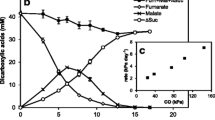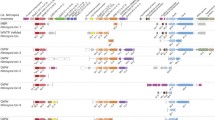Abstract
Escherichia coli K12 reduces nitrous oxide stoichiometrically to molecular nitrogen with rates of 1.9 μmol/h x mg protein. The activity is induced by anaerobiosis and nitrate. N2+formation from N2O is inhibited by C2H2 (K i ∼ 0.03 mM in the medium) and nitrite (K i=0.3 mM) but not by azide. A mutant defective in FNR synthesis is unable to reduce N2O to N2. The reaction in the wild type could routinely be followed by gas chromatography and alternatively by mass spectrometry measuring the formation of 15N2 from 15N2O. The enzyme catalyzing N2O-reduction in E. coli could not be identified; it is probably neither nitrate reductase nor nitrogenase. E. coli does not grow with N2O as sole respiratory electron acceptor. N2O-reduction might not have a physiological role in E. coli, and the enzyme involved might catalyze something else in nature, as it has a low affinity for the substrate N2O (apparent K m∼3.0 mM). The capability for N2O-reduction to N2 is not restricted to E. coli but is also demonstrable in Yersinia kristensenii and Buttiauxella agrestis of the Enterobacteriaceae. E. coli is able to produce NO and N2O from nitrite by nitrate reductase, depending on the assay conditions. In such experiments NO sup-inf2 is not reduced to N2 because of the high demand for N2O of N2O-reduction and the inhibitory effect of NO sup-inf2 on this reaction.
Similar content being viewed by others
References
Balderston WL, Sherr B, Payne WJ (1976) Blockage by acetylene of nitrous oxide reduction in Pseudomonas perfectomarina. Appl Environ Microbiol 31: 504–507.
Bleakley BH, Tiedje JM (1982) Nitrous oxide production by organisms other than nitrifiers and denitrifiers. Appl Environ Microbiol 44: 1342–1348.
Burns RC, Hardy RWF (1975) Nitrogen fixation in bacteria and higher plants. Springer, Heidelberg Berlin New York, p 189.
Carlson CA, Ingraham JL (1983) Comparison of denitrification by Pseudomonas stutzeri, Pseudomonas aeruginosa and Paracoccus denitrificans. Appl Environ Microbiol 45: 1247–1253.
Cataldo DA, Haroon M, Schrader LE, Youngs VL (1975) Rapid colorimetric determination of nitrate in plant tissue by nitration of salicylic acid. Commun Soil Sci Plant Anal 6: 71–80.
Cole JA, Brown CM (1980) Nitrite reduction to ammonia by fermentative bacteria: a short circuit in the biological nitrogen cycle. FEMS Microbiol Lett 7: 65–72.
Dean JV, Harper JE (1988) The conversion of nitrite to nitrogen oxide(s) by the constitutive NAD(P)H-nitrate reductase enzyme from soybean. Plant Physiol 88: 389–395.
DeMoss JA, Hsu P-Y (1991) NarK enhances nitrate uptake and nitrite excretion in Escherichia coli. J Bacteriol 173: 3303–3310.
Hardy RWF, Knight E (1966) Reduction of N2O by biological N2-fixing systems. Biochem Biophys Res Commun 23: 409–414.
Herbert D, Phipps PJ, Strange RE (1971) Chemical analysis of microbial cells. In: Norris JR, Ribbon DW (eds) Methods in microbiology, vol 5B. Academic Press, London New York, pp 209–304.
Ji X-B, Hollocher TC (1988a) Mechanisms of nitrosation of 2,3-diaminonaphthalene by Escherichia coli: enzymatic production of NO followed by O2-dependent chemical nitrosation. Appl Environ Microbiol 54: 1791–1794.
Ji X-B, Hollocher TC (1988b) Reduction of nitrite to nitric oxide by enteric bacteria. Biochem Biophys Res Commun 157: 106–108.
Kaspar HF (1982) Nitrite reduction to nitrous oxide by propionibacteria. Detoxification mechanism. Arch Microbiol 133: 126–130.
Klepper LA (1987) Nitric oxide emissions from soybean leaves during in vivo nitrate-reductase assays. Plant Physiol 85: 96–99.
Linne von Berg K-H, Bothe H (1992) The distribution of denitrifying bacteria in soils monitored by DNA-probing. FEMS Microbiol Ecol 86: 331–340.
Matsubara T (1975) The participation of cytochromes in the reduction of N2O to N2 by a denitrifying bacterium. J Biochem 77: 627–632.
Matsubara T, Mori T (1986) Studies on denitrification. IX. Nitrous oxide, its production and reduction to nitrogen. J Biochem 64: 863–871.
McEwan AG, Greenfield AJ, Wetzstein HG, Jackson JB, Ferguson SJ (1985) Nitrous oxide reduction by members of the family Rhodospirillaceae and the nitrous oxide reductase of Rhodopseudomonas capsulata. J Bacteriol 164: 823–830.
McNall EG, Atkinson DE (1956) Nitrate reduction. I. Growth of Escherichia coli with nitrate as sole source of nitrogen. J Bacteriol 72: 226–229.
Noji S, Nohno T, Saito T, Taniguchi S (1989) The narK gene product participates in nitrate transport induced in Escherichia coli nitrate respiring cells. FEBS Lett 252: 139–143.
Page L, Griffiths L, Cole JA (1990) Differential physiological roles of two independent pathways for nitrite reduction to ammonia by enteric bacteria. Arch Microbiol 154: 349–354.
Pichinoty F (1969) Les nitrate-reductases bactériennes. I. Substrats, état particulaire et inhibiteurs de l'enzyme A. Arch Mikrobiol 68: 51–64.
Sambrock J, Fritsch EF, Maniatis T (1989) Molecular cloning. A laboratory manual, 2nd ed. Appendix A3. Cold Spring Harbor Laboratory Press, Cold Spring Harbor NY.
Satoh T, Hom SSM, Shanmugam KT (1983) Production of nitrous oxide from nitrite in Klebsiella pneumoniae: mutants altered in nitrogen metabolism. J Bacteriol 155: 454–458.
Shaw DJ, Guest SN (1982) Amplification and product identification of the fnr gene of Escherichia coli. J Gen Microbiol 128: 2221–2228.
Sidransky E, Walter B, Hollocher TC (1978) Studies on the differential inhibition by azide on the nitrite/nitrous oxide level of denitrification. Appl Environ Microbiol 35: 247–250.
Smith MS (1982) Dissimilatory reduction of NO −2 to NH +4 and N2O by a soil Citrobacter sp. Appl Environ Microbiol 43: 854–860.
Smith MS (1983) Nitrous oxide production by Escherichia coli is correlated with nitrate reductase activity. Appl Environ Microbiol 45: 1545–1547.
Snell FD, Snell CT (1949) Colorimetric methods of analysis, 3rd ed. Van Nostrand, New York, pp 802–807.
Stewart V (1988) Nitrate respiration in relation to facultative metabolism in enterobacteria. Microbiol Rev 52: 190–232.
Stouthamer AH (1988) Dissimilatory reduction of oxidized nitrogen compounds. In: Zehnder JB (ed) Biology of anaerobic microorganisms. Wiley, London New York, pp 246–303.
Urbach W, Rupp W, Sturm H (1976) Experimente zur Stoffwechselphysiologie der Pflanzen. Thieme, Stuttgart, pp 218–222.
Voßwinkel R, Neidt I, Bothe H (1991) The production and utilization of nitric oxide by a new, denitrifying strain of Pseudomonas aeruginosa. Arch Microbiol 156: 62–69.
Yarbrough JM, Rake JB, Eagon RG (1980) Bacterial inhibitory effects of nitrite: inhibition of active transport but not of group translocation, and of intracellular enzymes. Appl Environ Microbiol 39: 831–834.
Yoshinari T (1980) N2O reduction by Vibrio succinogenes. Appl Environ Microbiol 39: 81–84.
Yoshinari T, Knowles R (1976) Acetylene inhibition of nitrous oxide reduction by denitrifying bacteria. Biochem Biophys Res Commun 69: 705–710.
Zimmer W, Penteado Stephan M, Bothe H (1984) Denitrification by Azospirillum brasilense Sp7.I. Growth with nitrite as respiratory electron acceptor. Arch Microbiol 138; 206–211.
Zumft WG, Viebrock A, Körner H (1988) Biochemical and physiological aspects of denitrification. In: Cole JA, Ferguson SJ (eds) The nitrogen and sulphur cycles. Cambridge University Press, Cambridge, pp 245–279.
Author information
Authors and Affiliations
Additional information
Dedicated to Professor L. Jaenicke, Köln, on the occassion of his 70th birthday
Rights and permissions
About this article
Cite this article
Kaldorf, M., Linne von Berg, K.H., Meier, U. et al. The reduction of nitrous oxide to dinitrogen by Escherichia coli . Arch. Microbiol. 160, 432–439 (1993). https://doi.org/10.1007/BF00245303
Received:
Accepted:
Issue Date:
DOI: https://doi.org/10.1007/BF00245303




